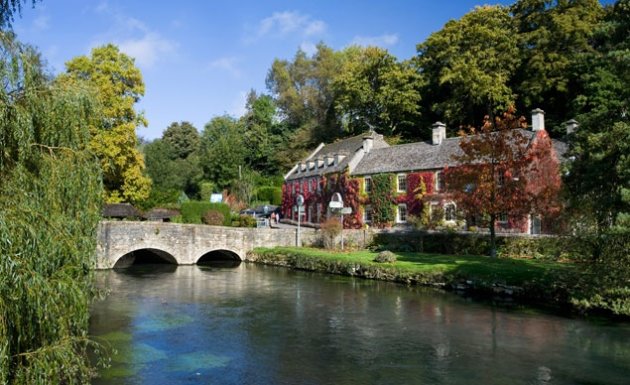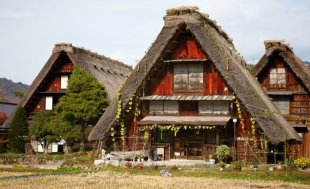World's 10 most picturesque villages - Yahoo! Travel
Spend a few minutes in these 10 villages and you'll realize that "quaint" and "charming" aren't just adjectives, they are a way of life. You'll find the unique beauty in the stone cottages of what has been dubbed the most beautiful village in England, and along cobblestone streets lined with Gothic architecture in the Bohemia valley of Czech Republic. These are all functioning towns, with residents who keep local industries alive (check out the century-old trout farm) as well as preserving the town's look, which is why there's no building "taller than a coconut tree" on a certain Hawaiian island. The locals will be happy to clue you in to the best photo ops as well. Some of the spots are easier to get to than others (we've provided detailed info on how to reach them all below), but all are worthy of taking a detour—and maxing out your camera's memory card.
Bibury, England
Located on the River Coln in hilly west-central England, Bibury was described by 19th-century artist-writer William Morris as "the most beautiful village in England"—which is saying something in a country known for its watercolor views. Honey-colored 17th-century stone cottages, the Saxon Church of St. Mary, and a still-working 1902 trout farm are some of the ancient village's must-sees. The most photographed spot is Arlington Row, a collection of 14th-century stone buildings that were converted into weavers' cottages in the 1600s.
Getting There: The closest train station to Bibury is 12 miles away, in Kemble. Multiple trains make the 80-minute journey from London's Paddington Station (from $57 round-trip; nationalrail.co.uk). Cirencester, seven miles away, is linked to London by daily buses (from $30 round-trip; nationalexpress.com). There is no public transport directly to Bibury, but taxis are available and local hotels will often arrange transport for guests.
Savoca, Italy
The ruins of the Castello di Pentefur stand guard above Savoca, a historic Sicilian village located on a hill between the cities of Messina and Taormina, on the island's east coast. Thought to be about 1,000 years old, the town was a stand-in for too-developed Corleone in The Godfather, and fans can still visit the Chiesa di Santa Lucia church on Via San Michele, where Michael Corleone was married, then trace the newlyweds' walk down to Bar Vitelli on Piazza Fossia for some cooling lemon granita. Don't miss a visit to the Cappuccini Monastery on the northern end of town to view the collection of mummified monks, some dating back to the 1700s.
Getting There: It's a little over an hour by car from the international airport in Catania to Savoca, or a scenic 40-minute drive from the popular resort town of Taormina. Many tour companies also offer day trips from Taormina, most of them with a Godfather theme ($170 for up to three people; sicilylimousineservice.com).
Sidi Bou Said, Tunisia
It's blue and white for as far as the eye can see in Sidi Bou Said. All of the buildings in this cliff-top village in northern Tunisia are stark white and adorned with vivid blue doors, shutters, and decorative ironwork—and backed by the deeper blues of the Bay of Tunis. Sometimes called the Montmartre of Tunisia, the village was a favorite of Swiss-German painter Paul Klee and writers Colette and Simone de Beauvoir. The bohemian vibe exists today, with day trippers coming to stroll the stone streets and visit the galleries and cafes.
Getting There: Sidi Bou Said is 13 miles from Tunis, and accessible via road or the TGM train (about $3 round-trip). Day tours are available.
Shirakawa-go, Japan
Declared a UNESCO World Heritage Site in 1995, Shirakawa-go is known for its triangle-roof houses, built in a style known as gassho, that resemble hands folded in prayer. The hallmarks of the houses are roofs with 60-degree slopes (to help the snow slide off more easily) and attics used as warm spots for raising silkworms in winter. Not many of the traditional houses remain in the area, and some in Shirakawa-go (including the Wada House and Nagase House) are regularly open to the public. Once you've seen the interiors, head to the top of Ogimachi Castle for the best views of the houses as well as the surrounding Shogawa River Valley and mountains.
Getting There: Take the four-hour train ride from Tokyo to the town of Takayama (about $178, includes a transfer in Nagoya, hyperdia.com). Nohi Bus operates several buses a day to Shirakawa-go. The ride takes about 50 minutes ($54 roundtrip, nouhibus.co.jp).
MORE AT BUDGET TRAVEL
Bibury, England
Located on the River Coln in hilly west-central England, Bibury was described by 19th-century artist-writer William Morris as "the most beautiful village in England"—which is saying something in a country known for its watercolor views. Honey-colored 17th-century stone cottages, the Saxon Church of St. Mary, and a still-working 1902 trout farm are some of the ancient village's must-sees. The most photographed spot is Arlington Row, a collection of 14th-century stone buildings that were converted into weavers' cottages in the 1600s.
Getting There: The closest train station to Bibury is 12 miles away, in Kemble. Multiple trains make the 80-minute journey from London's Paddington Station (from $57 round-trip; nationalrail.co.uk). Cirencester, seven miles away, is linked to London by daily buses (from $30 round-trip; nationalexpress.com). There is no public transport directly to Bibury, but taxis are available and local hotels will often arrange transport for guests.
Savoca, Italy
The ruins of the Castello di Pentefur stand guard above Savoca, a historic Sicilian village located on a hill between the cities of Messina and Taormina, on the island's east coast. Thought to be about 1,000 years old, the town was a stand-in for too-developed Corleone in The Godfather, and fans can still visit the Chiesa di Santa Lucia church on Via San Michele, where Michael Corleone was married, then trace the newlyweds' walk down to Bar Vitelli on Piazza Fossia for some cooling lemon granita. Don't miss a visit to the Cappuccini Monastery on the northern end of town to view the collection of mummified monks, some dating back to the 1700s.
Getting There: It's a little over an hour by car from the international airport in Catania to Savoca, or a scenic 40-minute drive from the popular resort town of Taormina. Many tour companies also offer day trips from Taormina, most of them with a Godfather theme ($170 for up to three people; sicilylimousineservice.com).
Sidi Bou Said, Tunisia
It's blue and white for as far as the eye can see in Sidi Bou Said. All of the buildings in this cliff-top village in northern Tunisia are stark white and adorned with vivid blue doors, shutters, and decorative ironwork—and backed by the deeper blues of the Bay of Tunis. Sometimes called the Montmartre of Tunisia, the village was a favorite of Swiss-German painter Paul Klee and writers Colette and Simone de Beauvoir. The bohemian vibe exists today, with day trippers coming to stroll the stone streets and visit the galleries and cafes.
Getting There: Sidi Bou Said is 13 miles from Tunis, and accessible via road or the TGM train (about $3 round-trip). Day tours are available.
Shirakawa-go, Japan
Declared a UNESCO World Heritage Site in 1995, Shirakawa-go is known for its triangle-roof houses, built in a style known as gassho, that resemble hands folded in prayer. The hallmarks of the houses are roofs with 60-degree slopes (to help the snow slide off more easily) and attics used as warm spots for raising silkworms in winter. Not many of the traditional houses remain in the area, and some in Shirakawa-go (including the Wada House and Nagase House) are regularly open to the public. Once you've seen the interiors, head to the top of Ogimachi Castle for the best views of the houses as well as the surrounding Shogawa River Valley and mountains.
Getting There: Take the four-hour train ride from Tokyo to the town of Takayama (about $178, includes a transfer in Nagoya, hyperdia.com). Nohi Bus operates several buses a day to Shirakawa-go. The ride takes about 50 minutes ($54 roundtrip, nouhibus.co.jp).




